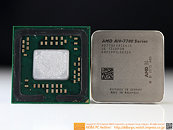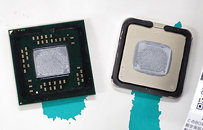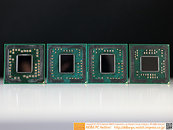Monday, January 20th 2014

AMD A10-7700K "Kaveri" De-lidded
Here are the first pictures of an AMD A10-7700K "Kaveri" APU with its integrated heat-spreader (IHS, or 'lid') removed. Put next to its predecessors, "Richland," "Trinity," and "Llano," AMD's new APU silicon is its biggest for the DIY PC market, more so because it's built on the 28 nm silicon fab process, compared to its predecessors being built on 32 nm. The die measures roughly 245 mm², and packs a staggering 2.41 billion transistors.
Under the IHS, AMD is using a thermal paste to transport heat from the die, and not a solder. The chip should be easy to de-lid, if you know what you're doing. Kaveri integrates two "Steamroller" x86-64 CPU modules with two cores each, a total of 4 MB of L2 cache, a massive on-die GPU with 512 stream processors based on the Graphics CoreNext micro-architecture, a dual-channel DDR3 IMC with hUMA and DDR3-2400 native support; and a PCI-Express 3.0 root complex.
Source:
Akiba PC Hotline
Under the IHS, AMD is using a thermal paste to transport heat from the die, and not a solder. The chip should be easy to de-lid, if you know what you're doing. Kaveri integrates two "Steamroller" x86-64 CPU modules with two cores each, a total of 4 MB of L2 cache, a massive on-die GPU with 512 stream processors based on the Graphics CoreNext micro-architecture, a dual-channel DDR3 IMC with hUMA and DDR3-2400 native support; and a PCI-Express 3.0 root complex.



27 Comments on AMD A10-7700K "Kaveri" De-lidded
Cant wait to get my hammer out again
As of right now the best process for OCing has got to be 32nm SOI(good on air water and LN2) and the worst is intel's 22nm(terrible on air/water ok on LN2) but this 28nm stuff might still be even worse.
I think he was referring toDoh, can't read. The switch from solder to paste is very unfortunate, IMO, because this only hurts the kind of people who are buying APUs in the first place: mainstream and budget.And btw, the LGA 775 P4s had already switched to the vent slot. The hole was only for socket 478 P4s like Northwood:
Compared to:
Soldered lids do not have 100% surface contact. A good TP can actually provide better temperatures than Solder because of greater surface area.